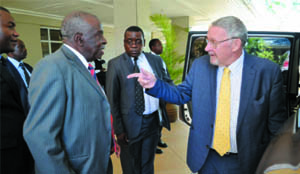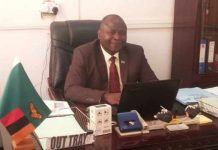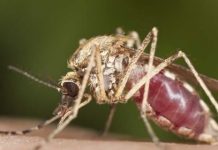By STEPHEN KAPAMBWE-
In the serene village of Kapimpa in Chinsali district of Zambian’s Northern Province lurks an unknown disease that locals have long associated with myth.
Until recently, medical experts could not explain the mysterious deaths arising from a strange condition that resulted in patients developing swollen joints before they bled to death.
Davies Musakanya is one such patient. He was born in 1972.
But as he grew, Davies realised that he was born in a family that was stalked by a deadly disease that soon began taking his brothers’ lives one at a time.
Of the seven brothers, four died after they developed swollen joints and bled profusely. Davies was no better.
He too developed swollen joints and everyone knew that it was a matter of time before his condition worsened.
In the village, Davies and his family were isolated.
Their neighbours suspected the family was at the receiving end of some kind of witchcraft or black magic.
The village knew the family, together with other families that had similar problems, had sought medical attention for their ailing members.
But there was no respite. Doctors could not even identify what disease had afflicted Davies, his whole family and the other families had.
Then one day, Zambia Childhood Cancer Foundation (ZACCAF) members from Lusaka visited Davies and suggested that they do medical tests on him.
By then, Davies could not stretch his hands or legs.
The joints in his arms and knees were swollen and painful. He could not walk.
He could only sit or lie down on a reed mat.
“This was the first time people were visiting my homestead because of my illness.
As you know, my family and I were isolated because of this condition,” Davies said.
The ZACCAF members had heard of the plight of Kapimpa village and travelled to verify the reports.
And true to the stories they heard, tests carried out on Davies and other patients with similar symptoms proved their fears; the village was being decimated by haemophilia, a hereditary bleeding disorder that not even medical personnel in Chinsali were accustomed to.
According to the World Federation of Haemophilia, haemophilia is a group of hereditary genetic disorders that impair the body’s ability to control blood clotting or coagulation, which is used to stop bleeding when a blood vessel is broken.
Haemophilia is quite rare, occurring in an estimated one in 10,000 people who are born with it.
It occurs in two types: Haemophilia A, which is clotting factor VIII deficiency, is the most common form of the disorder, and Haemophilia B, which is a factor IX deficiency that occurs in around one in about 20,000-34,000 male births.
Like most recessive sex-linked, X chromosome disorders, haemophilia is more likely to occur in males than females who are almost exclusively asymptomatic carriers of the disorder.
Haemophiliacs, or people suffering from the condition, do not bleed more intensely than people without it.
But they can bleed for a much longer time. In severe cases, even a minor injury can result in blood loss lasting days or weeks, or even never healing completely.
In areas such as the brain or inside joints, this can be fatal or permanently debilitating.
ZACCAF founding member Maurice Muchinda says Davies was one of an estimated 800 – 1400 people living with haemophilia in Zambia.
He says at the moment, there are only 15 registered patients living with the blood disorder in the country.
“We do not know yet where most of the haemophilia patients are.
However, we are aware that one rural district in North-Eastern Zambia, Chinsali, is suspected to have the highest number of people living with haemophilia,” he says.
That realisation put Kapimpa village on radar.
Further studies revealed that owing to ignorance and myths surrounding the disease, many people attributed the cause of haemophilia to witchcraft or some other cultural beliefs.
People were only prompted to seek medical help when confronted with prolonged bleeding episodes arising from the practice of tattooing or circumcision.
According to Mr Muchinda, who had lost a child to haemophilia, the status quo required concerted efforts to raise awareness about haemophilia, its transmission, symptoms and treatment.
That sensitisation starts from helping people in communities understand what haemophilia is.
Since the ailment is rare, few people, including medical practitioners working in certain far-flung areas know what it is.
Speaking at a recent ZACCAF corporate breakfast meeting where Vice-President Guy Scott was in attendance at Southern Sun Ridgeway Hotel in Lusaka, ZACCAF chairperson Charity Pikiti cited a number of issues that have contributed to the high number of deaths arising not just from haemophilia but from other causes as well.
She said the culture that most people have to seek medical attention only when a disease was in its late stage was, for example, causing many children suffering from cancer to die needlessly.
“The problem is that many children with cancer are being sent to the
University Teaching Hospital (UTH), for example, in their very late stage and we cannot help because the wards are full and we cannot keep those that are very sick in hospital.
One case was for a Mongu family that brought a child very late.
We had no choice but to send the child back to Mongu and it just lived for two weeks before it died,” she said.
She also blamed myths and traditional beliefs that she said had resulted in people living with haemophilia to be treated like outcasts.
She said because of the seriousness of negative beliefs, her organisation had resorted to taking some drugs to Chinsali instead of waiting for patients to be moved to Lusaka.
She said her organisation has also launched a training programme for local health personnel.
“We recently lost a life there because of lack of training. We have plans to train more people so that we help to save lives,” she said.
She also cited the issue of misdiagnosis that had contributed to haemophilia related deaths.
“One boy was misdiagnosed with sickle cell anaemia until he came to UTH in Lusaka where it was discovered that he had haemophilia.
This boy later died because when he travelled back to Chinsali, they could not stop his bleeding,” Mrs Pikiti said.
She explained that some haemophilia patients admitted that they only had inquiries concerning their bleeding when ZACCAF members visited Chinsali even though they had been to health facilities and were being treated for other ailments.
ZACCAF advisory committee member Professor Chifumbe Chintu said there were historical reasons to why certain ailments were strange to medical practitioners in the outskirts.
In his profession spanning more than 40 years at the UTH, Professor Chintu said there were a number of conditions that have been rare in the past, cancer in children having been one of them.
But that was not the case for sickle cell anaemia which was an inherited ailment that was very common.
In 1975, Professor Chintu encountered the first case of haemophilia that originated from Pemba in Southern Province.
To date, between 800 and 1,400 cases of haemophilia had been recorded in the country. Studies have also shown that the disease affects males, while females are only carriers.
The disease is thought not to be curable, although according to Professor Chintu, it could be cured with the priceless technique of bone marrow transplant.
Owing to the lack of information on the seriousness of the condition in the country and given the receptive position Government has assumed on healthcare delivery, Professor Chintu urged health institutions to collaborate their efforts to know the disease burden arising from haemophilia.
Dr Scott told a story of how he suffered a heart attack 25 years ago but doctors could not tell what it was because there was no ECG machine in the country.
He said just like doctors had missed his heart attack owing to lack of equipment then, haemophilia cases might be low because doctors in far flung areas might be poorly equipped to carry out effective diagnostics.
He said as far as haemophilia was concerned, the country required a health care delivery system that could take knowledge for both health practitioners and local communities to the outskirts, and deal with suspicions of witchcraft and other forms of superstition that only worsen the status quo.
“We cannot bring everyone to Lusaka, because what happens if we discover that hundreds and hundreds of people require treatment in those villages?” he asked.
He said the current Government had tasked three ministries, among them ministry of Health and the ministry of Community Development, Mother and Child Health to deal with the issue of health care delivery.
He said if necessary, organisations such as the Zambia Flying Doctor Services could be engaged to ensure people were not left to die needlessly.
Mrs Pikiti took the opportunity to inform Dr Scott that ZACCAF was formed to provide a holistic care system for children with cancer, life-threatening blood disorders and their families through practical and psycho-socio support programmes.
This would be achieved through programmes that focus on neglected non-communicable diseases, among them, the Childhood Cancer Programme, the Haemophilia Programme and the Sickle Cell Disease Programme.
ZACCAF is currently working towards establishing an in-patient palliative care ward-Hospice (linked to but away from UTH) for end of life care for paediatric haematology-onchology patients.
Being as a prerequisite to be a member of the World Federation of Haemophilia and the GAP programme, ZACCAF seeks to establish a sister organisation that would enhance the care for people living with haemophilia called the Haemophilia Foundation of Zambia.
The foundation that is expected to work in collaboration with the Fondazione Paracelso in Millan, Italy would be tasked with raising awareness about symptoms and signs of haemophilia, carrying out surveys to know how many people are leaving with the condition, screening and creation of a registry of patients.
The foundation will, among other things, create a Haemophilia Centre at the Zambia National Blood Transfusion Service that would be involved in diagnosis, treatment as well as act as a referral centre for the whole country.
Thanks to the work of ZACCAF, people like Davies had been assisted to travel to UTH where they have accessed life-saving drugs.
“They organised my coming to Lusaka where I was given drugs that I have never seen before,” said Davies who is now able to walk.
He appealed to the Government to ensure that people in villages like Kapimpa who were still suffering from haemophilia were assisted before they lost their lives.
The Government should also help train doctors in far flung areas on how to deal with diseases like haemophilia so that they are able to help the sick.
“Lots of people have died from this disease because of ignorance.
As I speak, I still have relatives suffering from the same disease,” Davies said.

 JOIN DRIVERN TAXI AS PARTNER DRIVER TODAY!
JOIN DRIVERN TAXI AS PARTNER DRIVER TODAY!











